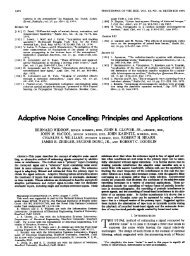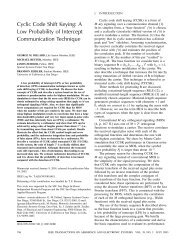Constant Envelope OFDM Phase Modulation - Dr. James R. Zeidler
Constant Envelope OFDM Phase Modulation - Dr. James R. Zeidler
Constant Envelope OFDM Phase Modulation - Dr. James R. Zeidler
You also want an ePaper? Increase the reach of your titles
YUMPU automatically turns print PDFs into web optimized ePapers that Google loves.
LIST OF FIGURES1.1 Representation of a wireless channel with multipath. . . . . . . . . . . . . 21.2 A wireless channel in time and frequency. . . . . . . . . . . . . . . . . . . 21.3 Intersymbol interference. . . . . . . . . . . . . . . . . . . . . . . . . . . . . 31.4 <strong>OFDM</strong> with cyclic prefix (CP). . . . . . . . . . . . . . . . . . . . . . . . . 51.5 Subcarrier and overall spectrum. (N = 16; |I 0,k | = 1, for all k) . . . . . . 71.6 <strong>OFDM</strong> converts wideband channel to N narrowband frequency bins. . . . 81.7 Frequency offset causes ICI. (ɛ fo = 0.25) . . . . . . . . . . . . . . . . . . . 91.8 A typical <strong>OFDM</strong> signal (N = 16). The PAPR is 9.5 dB. . . . . . . . . . . 101.9 Power amplifier transfer function. . . . . . . . . . . . . . . . . . . . . . . . 111.10 Comparison of <strong>OFDM</strong> and CE-<strong>OFDM</strong> signals. . . . . . . . . . . . . . . . 132.1 Sampling instances. . . . . . . . . . . . . . . . . . . . . . . . . . . . . . . . 192.2 Circular convolution with channel and the inverse channel. . . . . . . . . . 212.3 Block modulation with cyclic prefix and FDE. . . . . . . . . . . . . . . . . 212.4 <strong>OFDM</strong> is a special case. . . . . . . . . . . . . . . . . . . . . . . . . . . . . 212.5 <strong>OFDM</strong> system diagram. . . . . . . . . . . . . . . . . . . . . . . . . . . . . 232.6 Complementary cumulative distribution functions. (N = 64) . . . . . . . 252.7 PAPR CCDF lower bound (2.31) for N = 2 k , k = 5, 6, . . . , 10. . . . . . . . 262.8 AM/AM (solid) and AM/PM (dash) conversions (SSPA=thick, TWTA=thin)for various backoff ratios K. . . . . . . . . . . . . . . . . . . . . . . . . . . 292.9 Fractional out-of-band power of <strong>OFDM</strong> with ideal PA and with TWTAmodel at various input power backoff. (N = 64, IBO in dB) . . . . . . . . 312.10 Spectral growth versus IBO. (N = 64) . . . . . . . . . . . . . . . . . . . . 312.11 Performance of QPSK/<strong>OFDM</strong> with nonlinear power amplifier with variousinput power backoff levels. (N = 64) . . . . . . . . . . . . . . . . . . . . . 332.12 Performance of M-PSK/<strong>OFDM</strong> with SSPA. (N = 64) . . . . . . . . . . . 342.13 The potential range of system is reduced with input backoff; the range isreduced further from nonlinear amplifier distortion. . . . . . . . . . . . . . 362.14 Power amplifier efficiency. . . . . . . . . . . . . . . . . . . . . . . . . . . . 362.15 Block diagram. The system is evaluated with and without PAPR reduction. 382.16 Unclipped <strong>OFDM</strong> signal (9.25 dB PAPR). The rings have radius A maxwhich correspond to various clipping ratios γ clip (dB). . . . . . . . . . . . 39viii




